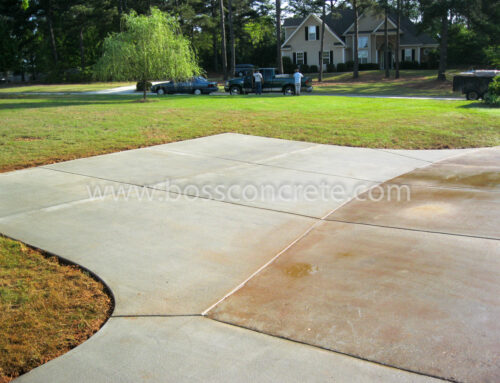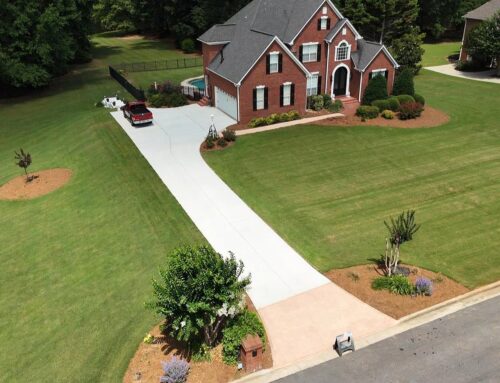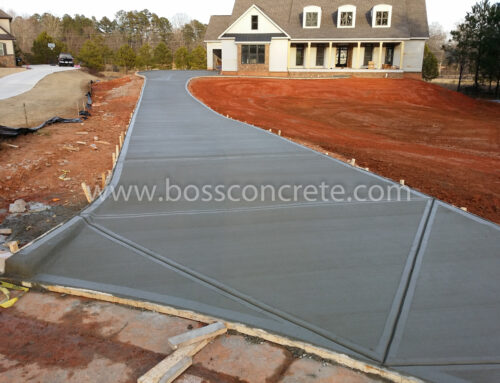On behalf of everyone here at BOSS, I would like to thank you very much for choosing us for your recent project. I trust we met or exceeded your expectations as your contractor. If not, I hope you will let me know and I’ll do my best to make it right.
Here are a few common questions we receive after the job is done. If you have a question that’s not answered here below, reach out to us and we’ll get back to you ASAP with the answer.
What can I expect now that my concrete is poured?
First, you should expect it to change color over time. Fresh concrete is a dark grey color, and as the curing process picks up speed you should expect your concrete to lighten up, becoming spotty and patchy in some areas at times. Any discoloration you observe should be temporary, and hydrating the concrete by spraying it with water for the first few days will speed up the color-change process.
You should wait a minimum of 3 days before you drive on it. Most concrete will be able to handle vehicle traffic after 3 days, and with side entrance garages you may need to wait another day before the concrete surface can handle the grinding action of car tires as they twist. You will be able to walk on your new concrete after approx. 24 hours. Use your best judgment with golf carts, but we recommend a minimum of two days if possible.
Concrete will develop cracks over time. This is mostly due to the concrete shrinking in volume as it gains strength. Concrete also shrinks and expands with changes in ambient temperature. Because of this, no one can prevent concrete from cracking, but we can control it with several methods. We place control joints at appropriate places during the pour in order to capture any cracks that will occur. These control joints allow for ‘weak spots’ making the crack likely to occur in the grooves that are created by the joints. If you have a driveway over 50 feet long, you can expect a few cracks to occur within the first few days. This is nothing to worry about, and the cracks should not open up over time.
Someone leaked oil on my new concrete. What should I do?
This is a common issue. There are several things you can try…lay some cat litter, sand, or other oil soaking product on it for a day or so. Then it would be a good idea to visit your local hardware store and ask them what products they have just for this problem…chances are good that they do. Soak the area with any detergent product you have, then spray it down with a hose. You can pressure wash, but keep the nozzle far enough from the surface to prevent damage, because pressure washing can wear off the surface of your concrete for good. Finally, just give it some time. I know it looks bad now, but with time it will fade on its own.
I’m noticing leaf stains and tire marks on my new concrete. What can I do about it?
Nothing to worry about. Concrete is very porous, and when leaves fall, the brownish color they have can leach into new concrete and leave a stain. There is no need to pressure wash or try to scrub the stains out. The stains left behind may last for awhile, but rest assured that they will dissipate with time.
My concrete was poured in the winter, and there are some darker patches in the surface. What can be done about it?
Concrete has a specific chemical that helps it to cure in the winter, and it’s called calcium chloride. A small percentage of driveways develop a gray tint because of this chemical, and it may be a bit patchy in spots. This issue is cosmetic in nature, as the concrete itself is strong and ready for use. But it may take some time for the gray tint to dissipate, and in some cases a full seasonal cycle will need to pass before noticeable improvement is observed. If you want to speed the process up, here are two things you can do. 1) Spray white vinegar all over the discolored areas, and wait a full day. You should notice that the acidity of the vinegar has reacted with the surface salt deposits that cause the discoloration and that the area has whitened. 2) Apply baking soda and scrub in with a deck brush, and wash off after an hour or so, and you should also see improvement.
I’ve been told that it’s a good idea to water the concrete down after it’s poured. Is that a good idea?
Yes, it will help. It’s not necessary though. Keeping concrete moist for a period of time will help alleviate the internal stress concrete experiences during the hydration process. It is most necessary for commercial applications, where there are vapor barriers underneath that prevent the concrete from curing evenly, or in hot or windy areas where the surface moisture is removed exceedingly fast. It’s never a bad idea to wet down the concrete, starting about 12 hours after it is poured, twice a day (dawn and dusk) for three days.





